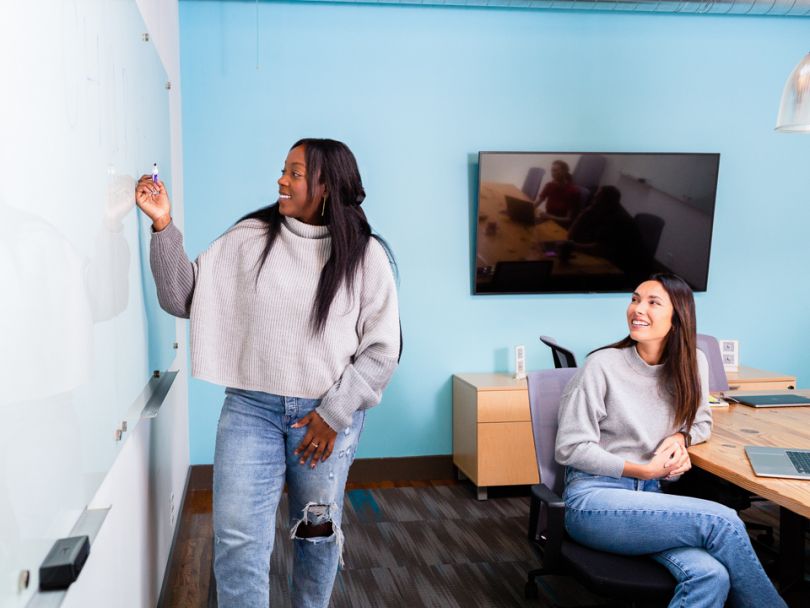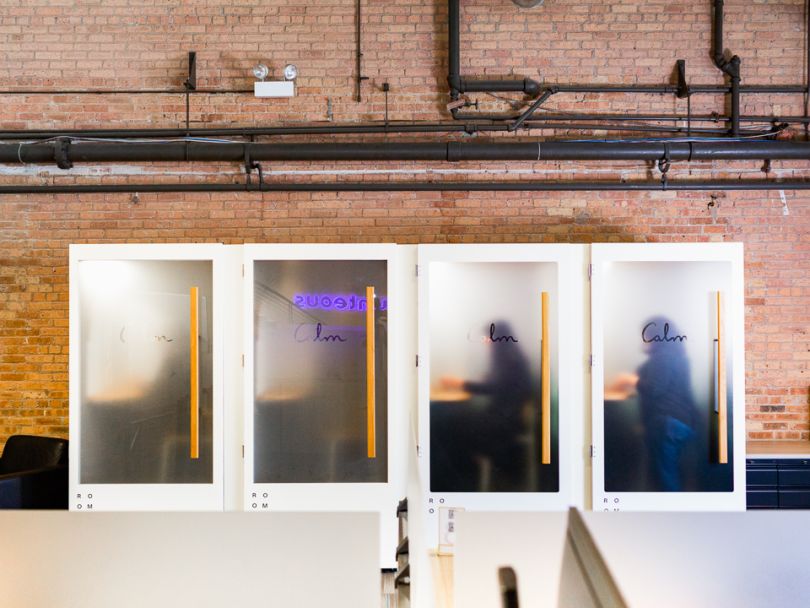Remember digging through your corner store’s cooler searching for a Coca-Cola bottle that had your name on it? That branding was part of the Share a Coke campaign, which launched in 2014. Digital experience agency Bounteous helped transform that campaign into a direct-to-consumer commerce experience that encompasses three brands and a multitude of products.
Their team helped Coke build a user-friendly commerce platform — the foundation of its brand experience. Then, Bounteous managed the creation of email, social and digital campaigns for Share a Coke. The team took charge of product and lifestyle photography, video, motion graphics and copywriting, too.
It’s that kind of professional impact that Bounteous Senior Vice President of Strategy and Insights Oscar Wang always knew she wanted to have. But what it comes down to for her, is who is alongside her on that journey. At Bounteous, she builds brand experiences alongside people who she describes as “the real deal.”
“You get to grow and learn together,” said Wang, senior vice president of strategy and insights. “It just doesn’t get better than that.”
The people she works with are co-creators and co-conspirators, and the culture they work in feeds on collaboration and a mutual respect for each other’s skills and ideas.
“We’re only constrained by our imagination, and it’s our imagination and our passion that is going to help create something new and different.”
While team members’ strengths span various crafts, the pieces come together in Bounteous’ unique approach to building brand experience: co-innovation. In essence, Bounteous doesn’t do work for a client, it does it arm-in-arm with the client.
Now, Share a Coke isn’t just a convenience store campaign. It’s an omnichannel brand experience that extends beyond traditional retail. And people can order customized Coke bottles with their name, wedding hashtag or any phrase they’d like.
Bounteous’ work with Coca-Cola is just one example of its commitment to sharing the challenge of problem-solving. That’s a powerful value proposition in a competitive agency environment. And Bounteous doesn’t want to be good. The company aims to be extraordinary.
Award-Winning Experiences
“Our challenge is to bring the magic of what the client has — in a way that’s most relevant and most compelling — to the audience,” said Michael McLaren, president, North Americas. “We’re only constrained by our imagination, and it’s our imagination and our passion that is going to help create something new and different.”

What does brand experience mean in your work?
Joanne Polott, Vice President of Insights, Strategy and Activation Growth: Brand and experience are two sides of the same coin. They’re inextricably linked. You can define your strategy for your brand all day long, and you can have wonderful ideas. But where the rubber meets the road is the experience that people in the world have of your brand. The more intentional you can be about the guardrails that you set out, the more evocative and the more transformative your experience can actually be in the world.
Oscar Wang, Senior Vice President of Strategy and Insights: The essence of strategy is really the intention of ambition. Brand experience strategy is where intention intersects with capabilities. But before you execute a roadmap, you need to safeguard the brand essence and translate that into the principles that guide execution. Brand strategy defines what the experience should look and feel and do for the brands. It should be cohesive to the brand house instead of going on its own digital track.
Michael McLaren, President, North Americas: It’s incumbent on the brand to understand the best way to engage with a customer and to create an added value experience from those interactions. It could be as simple as making the website more navigable so that consumers can easily discover content that they want. Or, it could be as radical as a completely new platform of engagement. The brand is building a relationship with the customer. It should be personalized, contextualized, relevant and valuable. And it plays out in every conceivable touchpoint with that customer.
If you have a smart strategy and you’re thinking holistically, then you can start helping clients make the right bets, because you can’t do everything. The client can focus on the things that matter most and create better experiences that are going to enforce that emotional and rational bonds with the brand.
Explain co-innovation and how it comes to life with your clients.
McLaren: The spirit of co-innovation is an agency partner who works hand in hand with clients to help them change the world. To do that, we’ve built a set of methodologies that allow us to wrestle with client problems and drive exciting, transformational thinking. Sometimes it’s innovation with a capital “I”: a complete transformation. Sometimes it’s innovation with a little “i.” They all count. By partnering with our clients, by locking arms with our clients, by truly understanding the business problem that they’re trying to solve, we can apply our experience and our smarts, in combination with theirs, so that it’s shared ownership.
All great things happen in collaboration and teamwork. If we can create an environment where you can’t tell which person is the agency and which person is the client, and we bring stakeholders with this vast range of capabilities and experience and backgrounds and cultural diversity and knowledge together, we can then create innovation and change. That’s an extremely powerful proposition for clients.
Polott: There are three big stages of co-innovation. There’s the alignment stage that helps us get on the same page. It helps us to understand where we should start innovating and where we should focus our efforts. Then we get into the value creation stage, which is all about doing the things in the world that actually drive growth and drive our business forward. Ultimately, you get to governance and optimization, which helps us make sure that we’re continually iterating, testing, learning and perfecting to make sure that we’re doing the right things at the right time. Each piece of this process is a cyclical loop where we’re creating new value. We’re also then having to align around another piece of the puzzle: We’re in the process of optimizing one aspect of the experience, and then we learn about another opportunity to hone a different aspect. We collaborate and continue to create value in new areas as we go.
“All great things happen in collaboration and teamwork. If we can create an environment where you can’t tell which person is the agency and which person is the client, we can then create innovation and change.”
Wang: Clients don’t need a $2 million-dollar strategy engagement. They don’t need a strategic consultancy that hands them a strategy and says, “you go do it.” They need co-innovation partnerships. This is in Bounteous’ DNA. We’re inventors. We’re craftspeople. Co-innovation came out of the question, “what do clients need, and where can we contribute?”
The Co-Innovation Manifesto
How do data and analytics influence the co-innovation approach?
Polott: I come from a background of upstream strategy. I have historically done a lot of primary research to really understand customer needs. That includes delving into various markets to understand what’s happening in them and asking how much life we will see if we change “x.” Such questions are fantastic in terms of predicting behaviors in the future, and it gives us a lens into the world of the potential customer experience. What I think is really interesting, and what has been fascinating for me about Bounteous, is that we can marry strategic primary research with real-time data and analytics of current performance. That marriage shows how these digital properties that companies have are actually performing in the world. It helps us ask how to combine the actual user behavior with what we think is going to happen moving forward.
In addition, when we think about bringing that into the co-innovation methodology, there’s no shortage of data. You are constantly thinking about what you can measure to understand if we’re actually making the difference that we want to make. That constant stream of data and the digital flow helps us help our clients get better as we go and figure out what the future looks like.

How does Bounteous encourage strategic thinking among team members?
Wang: Bounteous has craftspeople who are by nature strategic. When they approach a task, they trace it back to its intention. We’re creating a condition where people know their strategic intentions are appreciated and are coalesced into what’s good for the client. We have a title, we have a role to play in the growing organization going global, but we’re collaborators.
“We’re inventors. We’re craftspeople. Co-innovation came out of the question, what do clients need, and where can we contribute?”
Polott: We work with multidisciplinary teams every day of the week. Their curiosity really stands out. If you’re curious about something, you’re just going to continue digging to get at the root of the issue at play and how to solve it. That is how we inspire a culture of creativity and strategic thinking. We let people unleash what they bring to the table in a really meaningful way.
McLaren: There’s a wonderful old expression, “a great idea doesn’t care who has it.” We want to create a culture where everyone feels empowered to bring the best ideas they have. If we can do that, then chances are we’re going to help our clients drive toward better solutions, more strategic and more insightful solutions.








